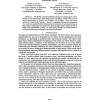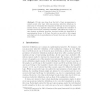347 search results - page 11 / 70 » Some Second Order Set Theory |
AAAI
1994
13 years 8 months ago
1994
We describe a method for learning formulas in firstorder logic using a brute-force, smallest-first search. The method is exceedingly simple. It generates all irreducible well-form...
TARK
1998
Springer
13 years 11 months ago
1998
Springer
We develop a revealed-preferencetheory for multiple agents. Some features of our construction, which draws heavily on Jeffrey's utility theory and on formal constructions by D...
LPNMR
2005
Springer
14 years 26 days ago
2005
Springer
ID-logic uses ideas from the field of logic programming to extend second order logic with non-monotone inductive defintions. In this work, we reformulate the semantics of this lo...
ASP
2005
Springer
14 years 27 days ago
2005
Springer
Preferences are useful when the space of feasible solutions of a given problem is dense but not all these solutions are equivalent w.r.t. some additional requirements. In this case...
GG
2004
Springer
14 years 22 days ago
2004
Springer
We show how edge-labelled graphs can be used to represent first-order logic formulae. This gives rise to recursively nested structures, in which each level of nesting corresponds ...


